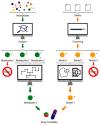Antifungal Agents in Agriculture: Friends and Foes of Public Health
- PMID: 31547546
- PMCID: PMC6843326
- DOI: 10.3390/biom9100521
Antifungal Agents in Agriculture: Friends and Foes of Public Health
Abstract
Fungal diseases have been underestimated worldwide but constitute a substantial threat to several plant and animal species as well as to public health. The increase in the global population has entailed an increase in the demand for agriculture in recent decades. Accordingly, there has been worldwide pressure to find means to improve the quality and productivity of agricultural crops. Antifungal agents have been widely used as an alternative for managing fungal diseases affecting several crops. However, the unregulated use of antifungals can jeopardize public health. Application of fungicides in agriculture should be under strict regulation to ensure the toxicological safety of commercialized foods. This review discusses the use of antifungals in agriculture worldwide, the need to develop new antifungals, and improvement of regulations regarding antifungal use.
Keywords: Antifungal agents; agriculture; chemoinformatics; fungicides.
Conflict of interest statement
The authors declare no conflicts of interest.
Figures



References
-
- Moore D., Ahmadjian V., Alexopoulos C.J. Fungus. Encyclopaedia Britannica, 2018. [(accessed on 10 January 2019)]; Available online: https://www.britannica.com/science/fungus/Importance-of-fungi.
Publication types
MeSH terms
Substances
LinkOut - more resources
Full Text Sources
Other Literature Sources

